Michail A. Makridis
Great GATsBi: Hybrid, Multimodal, Trajectory Forecasting for Bicycles using Anticipation Mechanism
Aug 20, 2025Abstract:Accurate prediction of road user movement is increasingly required by many applications ranging from advanced driver assistance systems to autonomous driving, and especially crucial for road safety. Even though most traffic accident fatalities account to bicycles, they have received little attention, as previous work focused mainly on pedestrians and motorized vehicles. In this work, we present the Great GATsBi, a domain-knowledge-based, hybrid, multimodal trajectory prediction framework for bicycles. The model incorporates both physics-based modeling (inspired by motorized vehicles) and social-based modeling (inspired by pedestrian movements) to explicitly account for the dual nature of bicycle movement. The social interactions are modeled with a graph attention network, and include decayed historical, but also anticipated, future trajectory data of a bicycles neighborhood, following recent insights from psychological and social studies. The results indicate that the proposed ensemble of physics models -- performing well in the short-term predictions -- and social models -- performing well in the long-term predictions -- exceeds state-of-the-art performance. We also conducted a controlled mass-cycling experiment to demonstrate the framework's performance when forecasting bicycle trajectories and modeling social interactions with road users.
Network-wide Freeway Traffic Estimation Using Sparse Sensor Data: A Dirichlet Graph Auto-Encoder Approach
Mar 20, 2025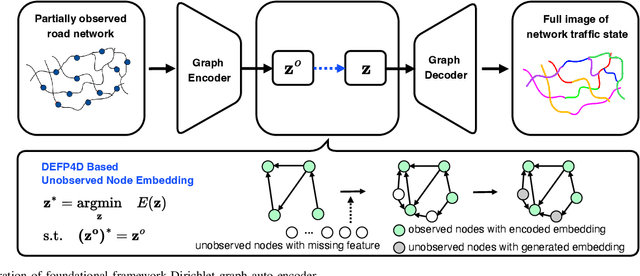
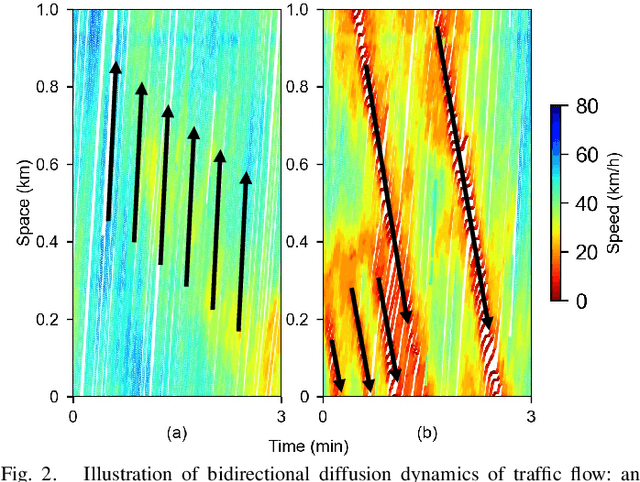
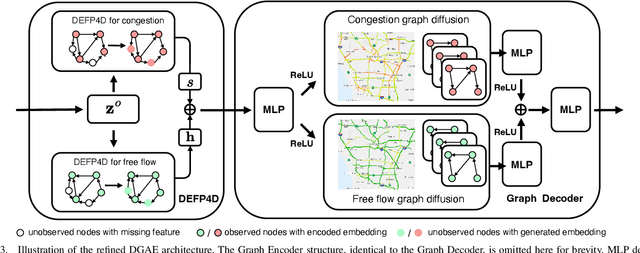
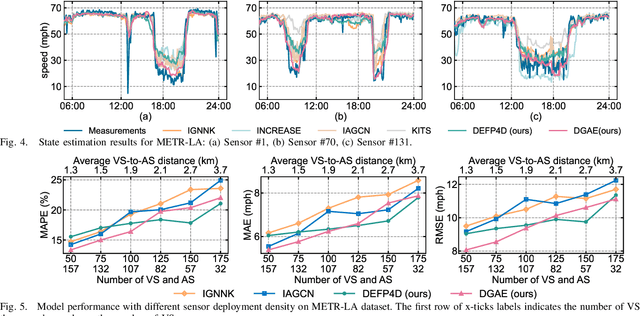
Abstract:Network-wide Traffic State Estimation (TSE), which aims to infer a complete image of network traffic states with sparsely deployed sensors, plays a vital role in intelligent transportation systems. With the development of data-driven methods, traffic dynamics modeling has advanced significantly. However, TSE poses fundamental challenges for data-driven approaches, since historical patterns cannot be learned locally at sensor-free segments. Although inductive graph learning shows promise in estimating states at locations without sensor, existing methods typically handle unobserved locations by filling them with zeros, introducing bias to the sensitive graph message propagation. The recently proposed Dirichlet Energy-based Feature Propagation (DEFP) method achieves State-Of-The-Art (SOTA) performance in unobserved node classification by eliminating the need for zero-filling. However, applying it to TSE faces three key challenges: inability to handle directed traffic networks, strong assumptions in traffic spatial correlation modeling, and overlooks distinct propagation rules of different patterns (e.g., congestion and free flow). We propose DGAE, a novel inductive graph representation model that addresses these challenges through theoretically derived DEFP for Directed graph (DEFP4D), enhanced spatial representation learning via DEFP4D-guided latent space encoding, and physics-guided propagation mechanisms that separately handles congested and free-flow patterns. Experiments on three traffic datasets demonstrate that DGAE outperforms existing SOTA methods and exhibits strong cross-city transferability. Furthermore, DEFP4D can serve as a standalone lightweight solution, showing superior performance under extremely sparse sensor conditions.
MoGERNN: An Inductive Traffic Predictor for Unobserved Locations in Dynamic Sensing Networks
Jan 21, 2025

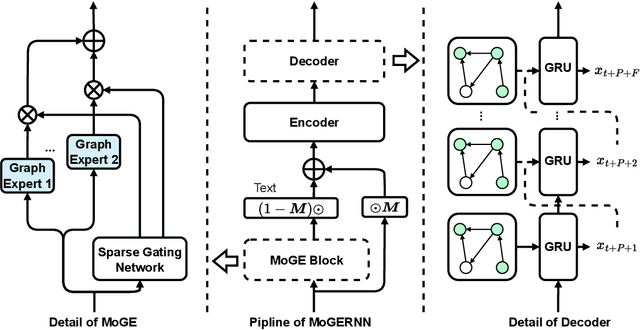
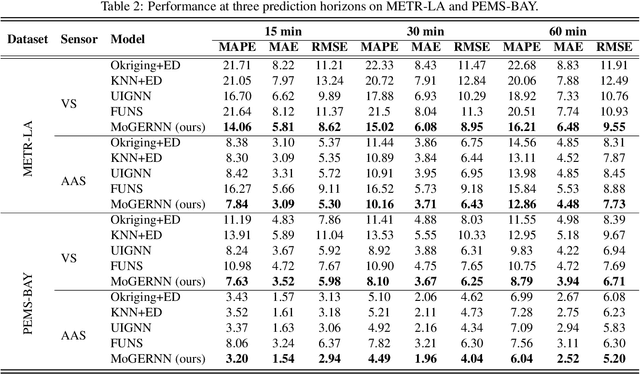
Abstract:Given a partially observed road network, how can we predict the traffic state of unobserved locations? While deep learning approaches show exceptional performance in traffic prediction, most assume sensors at all locations of interest, which is impractical due to financial constraints. Furthermore, these methods typically require costly retraining when sensor configurations change. We propose MoGERNN, an inductive spatio-temporal graph representation model, to address these challenges. Inspired by the Mixture of Experts approach in Large Language Models, we introduce a Mixture of Graph Expert (MoGE) block to model complex spatial dependencies through multiple graph message aggregators and a sparse gating network. This block estimates initial states for unobserved locations, which are then processed by a GRU-based Encoder-Decoder that integrates a graph message aggregator to capture spatio-temporal dependencies and predict future states. Experiments on two real-world datasets show MoGERNN consistently outperforms baseline methods for both observed and unobserved locations. MoGERNN can accurately predict congestion evolution even in areas without sensors, offering valuable information for traffic management. Moreover, MoGERNN is adaptable to dynamic sensing networks, maintaining competitive performance even compared to its retrained counterpart. Tests with different numbers of available sensors confirm its consistent superiority, and ablation studies validate the effectiveness of its key modules.
Time-to-Green predictions for fully-actuated signal control systems with supervised learning
Aug 24, 2022

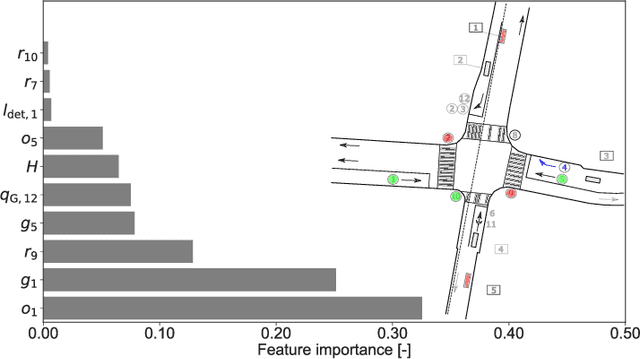
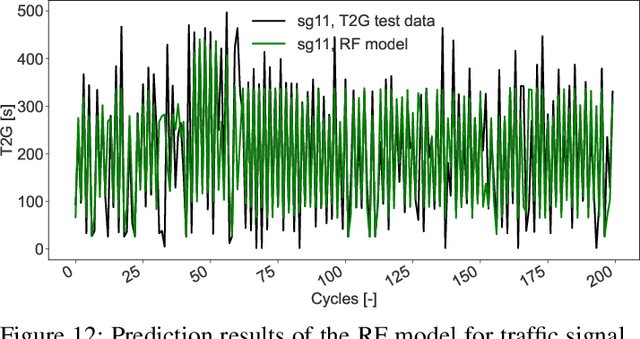
Abstract:Recently, efforts have been made to standardize signal phase and timing (SPaT) messages. These messages contain signal phase timings of all signalized intersection approaches. This information can thus be used for efficient motion planning, resulting in more homogeneous traffic flows and uniform speed profiles. Despite efforts to provide robust predictions for semi-actuated signal control systems, predicting signal phase timings for fully-actuated controls remains challenging. This paper proposes a time series prediction framework using aggregated traffic signal and loop detector data. We utilize state-of-the-art machine learning models to predict future signal phases' duration. The performance of a Linear Regression (LR), a Random Forest (RF), and a Long-Short-Term-Memory (LSTM) neural network are assessed against a naive baseline model. Results based on an empirical data set from a fully-actuated signal control system in Zurich, Switzerland, show that machine learning models outperform conventional prediction methods. Furthermore, tree-based decision models such as the RF perform best with an accuracy that meets requirements for practical applications.
 Add to Chrome
Add to Chrome Add to Firefox
Add to Firefox Add to Edge
Add to Edge